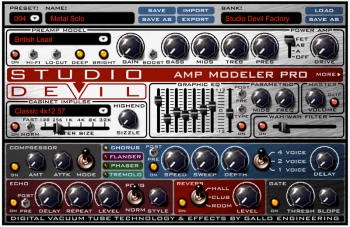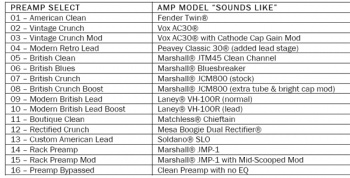Studio Devil Amp Modeller Pro v.1.0
(→Product Desription) |
(→Product Desription) |
||
| Line 31: | Line 31: | ||
particular setup. Every setup has a different impulse response…if you move the mic, change the speaker, do it in another | particular setup. Every setup has a different impulse response…if you move the mic, change the speaker, do it in another | ||
room, change anything at all...then you have a different impulse response, just like a fingerprint, unique to that particular | room, change anything at all...then you have a different impulse response, just like a fingerprint, unique to that particular | ||
| - | setup. | + | setup.<br> |
The impulse response is basically just a recorded audio file, typically saved in WAV or AIFF format, and it’s usually pretty | The impulse response is basically just a recorded audio file, typically saved in WAV or AIFF format, and it’s usually pretty | ||
short. After all, it’s just the recording of a short tick played though a speaker in a room. They can be mono, or stereo, | short. After all, it’s just the recording of a short tick played though a speaker in a room. They can be mono, or stereo, | ||
Revision as of 07:08, 26 October 2009
Contents |
General Information
Original Author: Staffay
Weapon: Computer Guitar Amp Simulator
Make: Gallo Engineering
Model: Studio Devil Amp Modeller Pro v.1.0
Price: $149.00
Introduction
When first visiting Studio Devils homepage, You get an impression that their product range must be a little lowbudget. But when You start to read, You quickly finds out that Robert Gallo (the constructor) actually has a patent on emulating the 12AX7A preamp tube. (the one used in most vintage/new amps) The product line consists of 3 guitar amp simulators (one FREE,one budget and the one tested here) and one bass(!) amp simulator. The soundclips on their site sound excellent, but are not linkable (otherwise, I would have put them here) Most of them are in Metal/Hard Rock style with distorsion.
Product Desription
Studio Devil emulates 15 different preamps, as the picture shows. There is also four different modes for the power amp. Class A, Class AB, FET and off. There is a modulation section with chorus/flange/phase/tremolo as well as a gate section, echo section, reverb section, speaker section, EQ and a passive wah-wah(!). The manual is very good and it's worth reading even if You dont have intentions to buy or use the software, since You will learn a lot of amp modelling and how tube amps really works. It is not until You read it, the secrets of this simple-looking software is revealed.
The pre-amp section has an open architecture, which let's You import new preamps from the manufactorer in form of .xml files. So does the speaker-emulation section, where You can import impulses from different speaker cabinets. The newest technique in computer room simulation is actually the convolution reverbs, which are built on impulses, and the text below is straight out of the manual.
About cabinet impulses:
When a cabinet impulse is made, the first thing that is done is a guitar cabinet, microphone, and room acoustics are all set
up to achieve a good tone, just like you would if you were about to record a real track, in a real studio. Then, once things
are sounding just right, a short tick, or pop, is played through the cabinet to record the way in which that particular setup
responds to a short electrical burst. The recorded response to this short tick is known as the “impulse response” for that
particular setup. Every setup has a different impulse response…if you move the mic, change the speaker, do it in another
room, change anything at all...then you have a different impulse response, just like a fingerprint, unique to that particular
setup.
The impulse response is basically just a recorded audio file, typically saved in WAV or AIFF format, and it’s usually pretty
short. After all, it’s just the recording of a short tick played though a speaker in a room. They can be mono, or stereo,
depending on how many mics were used in the setup, and they usually don’t run more than 1 second, with lengths of 2000
to 4000 samples being more common for short impulses from guitar cabinets. Before these WAV / AIFF impulse files are
saved, they are carefully trimmed and sliced so that there is no leading or trailing silence, much in the same way that loops
are cut down with sample accuracy to their start and end points. This is done so that the impulses can be used without
introducing unwanted latency and to be kept as short as possible to keep CPU usage down. Large impulses take more CPU
power to use than smaller ones, so keeping them as small as possible is always a good thing.
Sound
Feel
Overall Impression
Alternative Weapon
(Feel free to add other headings as appropriate for your review)
Specifications
- 15 Preamp Models cover every range of playing styles and modeled using Studio Devil’s proprietary digital vacuum tube modeling technology…nothing else sounds as real as Studio Devil because it uses exclusive and patented tube modeling algorithms!
- Authentic Tone Controls: Gain, Bass, Mids, Treble, and Presence controls that interact with your tone just like on real tube amps!
- Boost, Deep, and Bright Switches quickly liven up and adjust your tone!
- 3 Power Amp Models with Drive Control: Tube Class AB, Tube Class A, and Solid-State MOSFET to adjust natural power amp compression.
- Impulse Modeler / Cabinet Processor imports any WAV or AIFF file and features Zero-Latency switch, adjustable Filter Length, and High-end Sizzle controls!
- 32 Studio Devil Cabinets plus 58 ReCabinet® Demo impulses included!
- 7-Band Graphic-EQ with Master Level, 3 Modes, and Pre/Post Switch to position your EQ either at the input of your amp or in the send-return loop: pre or post distortion!
- Sweepable Parametric EQ with Mids Level and Frequency control knobs to custom tailor your tone!
- Wah-Wah Effect with adjustable pedal slider for a parked-Wah sound…or assign it to a MIDI controller for a real-time Wah!
- Compressor / Sustainer with two modes and Attack controls.
- 4 Studio Quality Modulation Effects: Chorus, Flanger, Phaser, and Tremolo all fully adjustable and can be positioned Pre/Post preamp to choose from that floor Pedal or Loop Effect sound!
- Echo / Delay Modeler with Normal / Stereo Ping-Pong Modes and continuously adjustable Style Knob: sweep from Analog Delay to Tape Echo or to Digital Delay and anywhere in between!
- World-Class Reverb with Level control and 3 Modes: Room, Club, and Hall.
- Noise Gate with adjustable Threshold and Gating Slope controls.
- Built-In Chromatic Tuner and Level Meters to stay in tune and to help maximize your signal level while guarding against digital clips.
- Master Volume control with Clip indicator.
- Import and Export Presets and Banks via XML files to share your tones with everyone via the Internet, email, and blogs!







